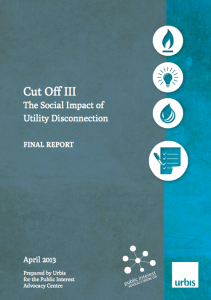Cut Off III: the social impact of utility disconnection Alternative formats available on request to PIAC - Contact PIAC
 This is the third research-based report by PIAC on electricity, gas and water disconnections for NSW residential consumers. The report was prepared for the Energy + Water Consumers’ Advocacy Program (EWCAP).
This is the third research-based report by PIAC on electricity, gas and water disconnections for NSW residential consumers. The report was prepared for the Energy + Water Consumers’ Advocacy Program (EWCAP).
Cut Off III analyses the circumstances that led to disconnection, the impacts of disconnection, and how people manage to finance reconnection. It is based on 171 surveys and four interviews with consumers disconnected in the second half of 2012. Findings are compared with Cut Off survey results from 2004 and 2008, noting a number of significant changes over the past eight years.
The research reveals that paid workers are just as likely as pensioners and the unemployed to be disconnected from electricity, gas or water. Disconnection is most often the result of long-term financial stress rather than a one-off event. Furthermore, a significant number of respondents reported an unusually high utility bill and debt prior to disconnection. There was also a high proportion of people who felt that retailer payment plans were unaffordable, and a large number of people did not know that vouchers or payment assistance existed to pay utility bills in emergency situations. This suggests a strong need to improve and promote existing support services and for utility retailers to engage with consumers in ways that are tailored to their needs to avoid disconnection, especially for paid workers who may not be eligible for government assistance.
Cover title: Cut Off III. The social impact of utility disconnection. Final report